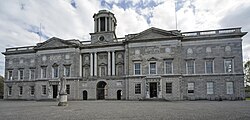James Gandon
James Gandon (born February 20, 1742 in London , † December 24, 1823 in Lucan near Dublin ) was a British architect and engraver . Gandon is regarded as the leading architect in Dublin at the time of classicism and with his monumental public buildings significantly shaped the appearance of the city.
life and work
Education and time in London (1742–1781)
James Gandon was born in London as a descendant of Huguenot refugees. From 1757 he received training from Sir William Chambers and worked independently in England from 1765 . He took architecture courses at the newly founded Royal Academy of Arts and won one of the first competitions there. Due to the bad order situation in London, he first tried to become known through publications and together with John Woolfe published two supplementary volumes (1767 and 1771) of the table work Vitruvius Britannicus by Colen Campbell . Gandon's designs for Shire Hall in Nottingham can also be found in the work.
First connections to Ireland were made in 1768 when he won second prize for the design of the Dublin Stock Exchange . In 1772 his son James Gandon junior was born, who himself worked as an architect and in 1846 published his first biography of his father. In 1775 Gandon studied the works of Charles-Louis Clérisseau and copied some of his drawings. At the same time he was engaged in copperplate engraving and made five sheets after drawings by Richard Wilson , which show ancient buildings such as the baths of Diocletian . In 1776 he won another architecture award for the design of St. Luke Hospital in London.
Moved to Ireland (1781–1823)
Important for his later move to Dublin in 1781 were his acquaintances with John Dawson, 1st Earl of Portarlington , who invited him to Ireland, and with John Beresford . Beresford commissioned the design of the Dublin Custom House in 1780 and later supported him as a sponsor, client and influential politician. Gandon declined an invitation from Catherine II to Saint Petersburg and in 1781 finally decided on Dublin.
There he designed the Custom House (customs building) including docks and quays until 1791 , which was strongly influenced by the Roman architecture of his teacher Sir William Chambers. The success of the building brought him the order to expand the parliament building (1784–1789), which he had equipped with a Corinthian portico , even before completion . In 1786 he was entrusted with the completion of the Four Courts , which were started in 1770 by Thomas Cooley for the Irish National Archives and remained unfinished after his death in 1784. Gandon integrated Cooley's work into his own plans and completed the building in the required new function and enlarged form.
| Buildings in Dublin | |||

South facade of the Custom House
|
|||
During the political unrest of 1798/1799 Gandon fled to London for a short time, but remained active for the rest of his life in Dublin, where he had finally established himself artistically. From 1799 he designed the King's Inns , the completion of which he was unable to complete due to health problems. As a result, he handed the project over to his students Henry Aaron Baker and Francis Johnston in 1805 and retired to his country estate Canonbrook in Lucan near Dublin.
Own writings
- James Gandon, John Woolfe : Vitruvius Britannicus (supplementary volumes), London 1767.
literature
- J. Gandon Jr., T. Mulvany: The Life of James Gandon. London 1969.
- Wolf Stadler u. a .: Lexicon of Art 5th Gal - Mr. Karl Müller Verlag, Erlangen 1994, ISBN 3-86070-452-4 , p. 10.
- Hugo Duffy: James Gandon and his Times. Gandon Editions, Kinsale 1999, ISBN 0946846286 .
- Sven Hauschke: Gandon, James . In: General Artist Lexicon . The visual artists of all times and peoples (AKL). Volume 48, Saur, Munich a. a. 2006, ISBN 3-598-22788-4 , p. 355.
Web links
- James Gandon. In: Structurae
- Biography (English)
Individual evidence
- ↑ a b c d e f Sven Hauschke: Gandon, James . In: General Artist Lexicon . The visual artists of all times and peoples (AKL). Volume 48, Saur, Munich a. a. 2006, ISBN 3-598-22788-4 , p. 355.
- ↑ a b Wolf Stadler: Lexikon der Kunst 5 , 1994, p. 10.
| personal data | |
|---|---|
| SURNAME | Gandon, James |
| BRIEF DESCRIPTION | British architect |
| DATE OF BIRTH | February 20, 1742 |
| PLACE OF BIRTH | London |
| DATE OF DEATH | December 24, 1823 |
| Place of death | Lucan |


